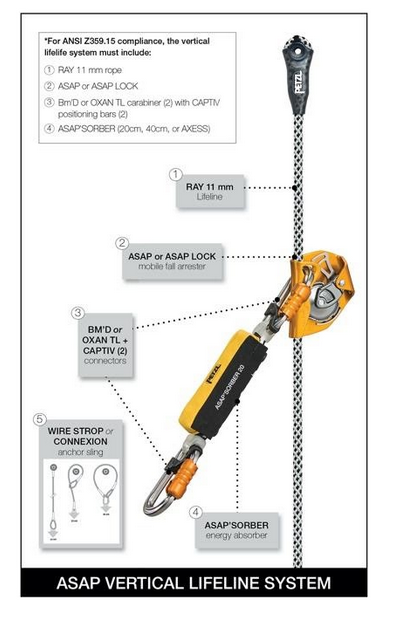
Tower climbers find themselves hundreds, even 1,000-plus feet off the ground. The misconception that the space between the climber and ground translates to more clearance to stop the fall can prove fatal, given the numerous obstacles along the way. “All falls on towers must be stopped as quickly as possible to avoid hitting foot pegs, angle iron cross members or other solid structures that might be in your path during the free fall and deceleration distances of your fall,” says Goulet.
The ASAP® Vertical Lifeline, backed by years of research, development and proven field use, is a temporary fall protection system designed to protect against falls from height. It contains separate, but complementary components including the RAY 11 mm lifeline, ASAP or ASAP Lock mobile fall arrester, BM’D or OXAN TL carabiner with CAPTIV positioning bars, ASAP’SORBER (20 cm, 40 cm or AXESS) energy absorbers and WIRE STROP, or textile CONNEXION anchor strap.
When it comes to stopping a fall, there is not a millisecond to spare. The ASAP is appropriately named. “Its functionality is a little bit like a car seatbelt,” explains Goulet, “if you pull out your seatbelt too quickly, the seatbelt jams up.” When a fall, slide, or an uncontrolled descent occurs, centrifugal force is applied to the ASAP wheel as it turns, due to contact with the lifeline. It stops rotating, assumes lock position and pinches the rope between the wheel and the ASAP’s body, thereby stopping the fall.
The ASAP or ASAP LOCK mobile fall arrester does not require any manual intervention during use, allowing technicians to focus on the task at hand. It parallels the climber up and down, without interference, creating “less room for error.”
For a free fall distance of less than 2 feet, think ladder or structure climbing, the ASAP personal fall arrest system can be connected to the sternal harness connection point (or as per your local regulatory requirements). When technicians are subject to longer free falls, the ASAP is connected to the dorsal harness d-ring. During tower erections, RAY 11 lifelines can be pre-installed on each corners of the tower sections before being lifted into place. This facilitates and safeguards access to the top of that section after it has been bolted into place. Simply connect your ASAP fall arrester to the lifeline, then climb the next section.
When performing tower strengthening work, it accommodates versatile movement; left to right and up and down. “You don’t have to worry about disconnecting and reconnecting your twin leg lanyard as you’re always connected with the ASAP system. Caution is needed to avoid pendulum falls of course, which may be controlled with the use of your positioning lanyards. You can cover a much broader area,” says Goulet. Installing and clamping tower cables in vertical trays, for instance, can be easily done on a rope descent system, which requires the use of a secondary vertical lifeline system for redundancy and regulatory compliance.
“When you’re down-climbing a 200-foot tower ladder, you don’t have to lean out on your ladder system fall arrester to get it to move with you,” says Goulet. The ASAP Vertical Lifeline fall arrester is “a silent partner. Once you have it properly installed on the rope, you can go up and down the tower all day long during your more complex work projects, and it will follow you with just a slight tug,” says Goulet.
The ASAP meets dynamic performance, conditioning and residual static strength tests as prescribed by ANSI Z359.15 standards. It’s one of Goulet’s favorite Petzl products, which is saying something. “Its engineering is outstanding. There are very few ways to defeat the functionality of this device. Its design takes into consideration what is likely to happen during a fall,” says Goulet. “We’re only human when we’re falling.” When the survival instinct kicks in, technicians facing a fall may be inclined to clutch the fall arrester.
Many fall arresters are based on a lever design, according to Goulet. “The problem with that is if you grab the rope above your fall arrester or the lever itself, you might be able to defeat the functionality of the device and slide to the end of the rope.” Fortunately, the ASAP works differently, and it will engage the lifeline even if inadvertently grabbed during a fall or over-sped descent.
Like all fall protection equipment, the ASAP is only valuable if used properly. Petzl prides itself on clear instructional documents provided with every product. “We know that worksite environments are three dimensional and that many technicians learn their crafts with visual aids,” says Goulet. Petzl provides detailed illustrations to depict proper usage and pertinent information so technicians better understand how the product works.
Petzl offers several related ANSI/CSA rated products including the NEWTON fall arrest harnesses, the VOLT fall arrest and positioning harnesses and the AVAO Fall Arrest, Work Positioning and Suspension harnesses. Along with the wire STROP and textile CONNEXION anchoring straps, Petzl offers the VULCAN and OXAN steel connectors.
Petzl America has Technical Sales Representatives who can be available to demonstrate products anywhere in the U.S. and Canada. It distributes products through several key Authorized Dealers in the telecom industry. Petzl also endorses premier training organizations who provide solutions training under their Technical Partner program. For more information, visit www.petzl.com/professional or contact professionalsales@petzl.com.






Reader Interactions